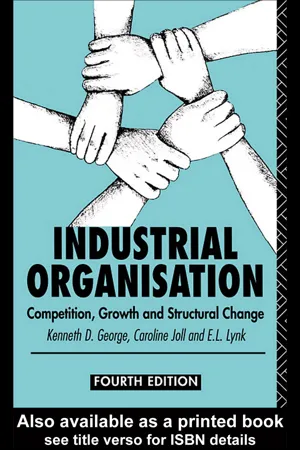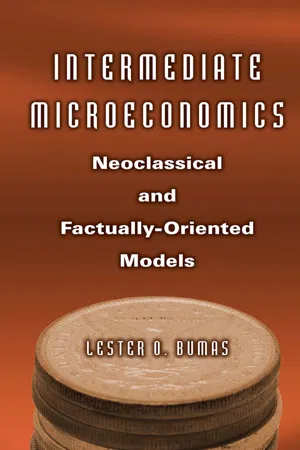Economics
Natural Monopoly
A natural monopoly occurs when a single firm can produce a good or service at a lower cost than multiple competing firms due to economies of scale. This can lead to a situation where it is more efficient to have a single provider in the market, as the fixed costs are high and average costs decrease as output increases. Natural monopolies are often regulated to prevent abuse of market power.
Written by Perlego with AI-assistance
Related key terms
4 Key excerpts on "Natural Monopoly"
- eBook - ePub
Industrial Organization
Competition, Growth and Structural Change
- Kenneth George, Caroline Joll, E L Lynk(Authors)
- 2005(Publication Date)
- Routledge(Publisher)
Chapter 13 Natural Monopoly 13.1 INTRODUCTION The previous chapter dealt with the costs that the incidence of private monopoly may impose upon society owing to the lower levels of output and higher prices than would prevail under a competitive environment. Clearly the outcome of such an approach is that, at the static level at least, monopoly may be undesirable from the viewpoint of economic efficiency. However, there are instances where efficiency dictates that demand is met by a single producer. This is the case of Natural Monopoly. In such a situation the costs of supply exhibit characteristics such that single-firm production is always more efficient than multi-firm production. In the single-product case such a situation is caused by substantial (and often unexploited) economies of scale induced by a high fixed cost component. In a multiproduct industry it is largely caused by a combination of economies of scale and scope. In such circumstances there is clearly a public policy problem. This is because, although efficiency requires single-firm production, this may occur at the expense of allocative efficiency. The monopolist is in a powerful position to charge prices that more than cover costs of production. The Natural Monopoly problem therefore is one of ensuring that industry output is produced at minimum cost (private and social) and sold at prices that reflect these costs. The postwar approach in the UK until the 1980s was the exclusive public ownership of such activities. Apparent dissatisfaction with this solution has led to the recent programme of privatisation accompanied by regulation. In this chapter we first consider the conditions which give rise to the Natural Monopoly problem and the welfare issues raised. We also look at the practical policy issues raised and the ‘solutions’ adopted: public ownership (section 13.4), privatisation (section 13.5) and regulation (section 13.6) - eBook - ePub
Intermediate Microeconomics: Neoclassical and Factually-oriented Models
Neoclassical and Factually-oriented Models
- Lester O. Bumas(Author)
- 2015(Publication Date)
- Routledge(Publisher)
Monopolies with the power to set price have the power to set it unreasonably high. That some unregulated monopolies charge no more than regulated monopolies may well be due to the fear that those which are unregulated may will lose that status if their prices are unreasonably high. There is in addition the profound problem of the political power of monopolies and big business in general. They have great influence on government at all levels and make a mockery of the essence of democracy which can be characterized as “one person, one vote.” And if monopolies, big business, and banks seem to be sinking they tend to be bailed-out by the government in what appears to be an arrangement in which risk is socialized and profits privatized.Summary
Monopolies and monopolization play an important role in our economy and its history. There are two kinds of monopolies, natural and unnatural. Natural monopolies exist because they can produce more cheaply than two or more firms in a market. They are the beneficiaries of economies of scale. But in choosing the most efficient size of plant, production is expected to take place in the declining range of the average cost function, the range in which marginal cost is lower than average cost. This precludes the efficient allocation of resources as manifest in marginal cost pricing. Moreover, if a natural monopolist wants to avoid being displaced by a rival, it must choose its plant size based on the normal rate of return rather than profit maximization.Unnatural monopolies arise from numerous sources: government grants of monopoly status in the form of patents and franchises; the control of necessary resources; and the historic establishment of organizational forms such as pools, trusts, holding companies, and cartels. And while unnatural monopolies do not have the advantage of economies of scale, by going to multiplant operations they can largely avoid diseconomies of scale.Price discrimination is practiced by monopolies (and other price-setting firms). This is obvious in the case of public utilities, which tend to have different rate schedules for residential, business, and religious institutions. Price discrimination can be a tool for increasing profits beyond that possible with a single price. Utilities frequently have a monthly base charge. This means that price varies with the rate of consumption: the lower the number of units purchased, the higher is the per unit price. - eBook - ePub
- Karl G. Heider(Author)
- 2017(Publication Date)
- Routledge(Publisher)
The word monopoly comes from two Greek words meaning “one” and “merchant,” i.e., only one seller of a commodity. What is meant by a commodity, or the basis for classifying the products of two enterprises as different commodities, is a matter of large uncertainty, as already pointed out. An enterprise is not thought of as a monopoly unless it is in a position to charge a price above that at which other persons could produce an equivalent commodity, and would do so if not prevented by some special barrier. The nature of the barrier determines the kind of monopoly in the customary classification. The barrier, in the case of the old monopolies, in connection with which the word was first used, was the law. Rulers granted monopolies as gifts to favorites, or sold them to raise revenue. This kind of monopoly is represented today by the patent right given an inventor, copyright on books, etc., though these are established as a matter of social policy. It is called a “legal” monopoly. No exhaustive classification of monopolies will be attempted here. A legal monopoly may be retained by the government itself to raise revenue when it is called a “fiscal monopoly,” or it may be retained to control the consumption of the commodity, or for other reasons, and given other names. The term “Natural Monopoly” is in general use, but refers to a number of different situations. The most common is that of industries such as gas and water works which require a fixed investment to serve a given market which it would involve enormous waste to duplicate. Another important class is that sometimes called “capitalistic” monopolies, in which the barrier preventing competition is the threat of “unfair” competition of some sort.The outstanding evil of monopoly is of course the burden under which it places the consumer of paying a higher price for the commodity than is necessary, and allowing the owner of the monopoly an unearned income—if it is - eBook - ePub
- Richard A. Posner(Author)
- 1999(Publication Date)
- Cato Institute(Publisher)
ECON. J. 224 (1967). 32 One could, of course, argue that the opportunity to reap Natural Monopoly profits may bias private inventive activity in the direction of process or product innovations that lend themselves to monopolistic exploitation because they involve large economies of scale. 33 For a fuller discussion of price discrimination by natural monopolists see text accompanying notes 43-49 infra. 34 A further point is that the creation of a Natural Monopoly will—paradoxically— usually make the consumer better off than, he was before, even if he must pay a very high monopoly price. Most natural monopolies have arisen not from changes in the methods of producing existing products or services but from the creation of new services—such as telegraphy, telephony, and electric power. The cost of a new service to the consumer, including whatever monopoly profit the seller is able to include, must be lower than that of the service it displaced; otherwise it would not have displaced the old service. But perhaps the proper comparison is not between today's consumers and yesterday's but among present-day consumers. Also, one should note that the displacement of an existing by a new service may harm some consumers—those who preferred the former service but could not sustain it by themselves when most of their fellow consumers switched to the new. 35 At the end of 1967, pension funds and nonprofit institutions held roughly 12 percent (by market value) of the stock listed on the New York Stock Exchange, and mutual insurance and savings institutions held additional substantial amounts. Computed from NEW YORK STOCK EXCHANGE, 1968 FACT BOOK 42 (1968). More than 50 percent of the shareholders of public corporations had a reported household income of less than $10,000 per year. Computed from NEW YORK STOCK EXCHANGE, 1965 CENSUS OF SHAREOWNERS 15 (1965)
Learn about this page
Index pages curate the most relevant extracts from our library of academic textbooks. They’ve been created using an in-house natural language model (NLM), each adding context and meaning to key research topics.



